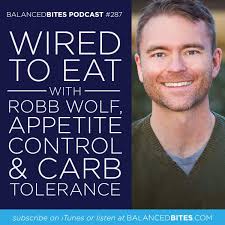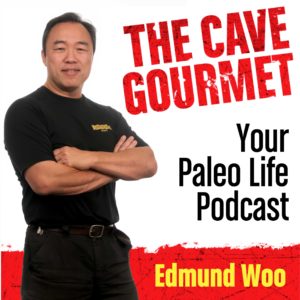A modern pioneer in the paleo movement, Robb’s shift into paleo came in the late ‘90s after debating over whether or not to go to medical school, which coincided with his health problems at the time (ulcerative colitis). He was following a high-carb low-fat vegan diet, which wasn’t working well. The end point was the idea of an ancestral health perspective that came on his radar, and once he began experimenting, it reversed his ulcerative colitis and changed his life. He worked on some papers with Dr. Loren Cordain, and he discovered an online workout called CrossFit, ultimately opening the first CrossFit-affiliate gym in the world. He was fortunate enough to watch the paleo diet and CrossFit grow in lockstep together, from only a few hundred people on the planet knowing about these movements.
7:30
I have a lot of clients that still get caught up with dietary misperceptions, (e.g. being terrified of fat), and I’m not sure how long it takes to get beyond that.
If you can just get people eating in a way where their palate and satiety are fired in a way that we eat enough to support our activity but we’re not causing any damage to our health, that’s a big eye-opener. Usually the magic sauce for that ends up being a higher-protein, moderate-to-low-carb approach. Many people say, “You need to just eat less and move more,” but that goes against our genetic wiring. People who emphasize the “calories in, calories out” mentality are forgetting that we live in a world of hyper-palatable foods and that our fundamental genetic wiring tells us that eating as much of that as we can is a good idea. It’s only in our modern environment of plenty that that has become a liability instead of an asset.
11:00
Many of these companies are out for a profit, which requires them to sell more.
The industrialized food folks who are profiting from our situation intimately understand this ancestral health model and how our brains can be hijacked to become dependent on something, whether it’s a Facebook app or a potato chip. Yet most doctors, media and healthcare providers are still completely dismissive of the paleo diet and this idea and basically leave us to the designs of the folks that are profiting from us—junk food purveyors and media players—and offer us nothing of value in return.
14:40
It’d be interesting to take these techniques that make us unable to eat just one chip, but turn them around and use them in a healthy way.
Part of the problem is similar to the difference between chewing the coca leaf which is mildly addictive like coffee vs. refining it into cocaine and it being off-the-Richter-scale addictive.
18:00
How do we help people rewire their thinking to turn off cravings for carbs, sugar, and wine or alcohol in the evening?
When you’re hungry, if somebody puts anything reasonable in front of you you’re going to say, “OK, I’m going to eat that.” When we’re in a mode of cravings, we’re seeking out some specific thing, and cravings are more akin to drug interactions. With things like wheat, dairy or sugar that are known to have opiate-type effects on the brain and gut, people really want these foods because they affectively become addictive and these cravings are driven because they’ve habituated to using them. The reality is that there’s going to be some struggle and discomfort in decoupling from that. Being addicted to processed foods is not that dissimilar to the process of getting cleaned up from drugs and alcohol, and there are not really any easy solutions, other than recognizing at the outset that this isn’t an easy process. Understand we are genetically wired to eat more and move less.
22:00
If you’re wanting to get a handle on your food, you’ve got to get a handle on your sleep, which ties into the wine. Wine disorders your sleep and helps you to be unconscious but it doesn’t help you sleep, and if you’re not sleeping, you have less impulse control and a tendency to seek out salty, sweet, refined foods. Just be aware that drinking around bedtime isn’t helping your sleep and increases your tendency to choose poor food options.
27:30
I have mixed feelings on restrictive diets or “cheat meals.” It sets people up for failure right out of the gate. A specific event like that can create an enormous amount of participatory energy, like a drug addict enjoys the process of preparing to take the drug just as much as the actual taking of the drug. That can have profound impacts on the neuro-regulation of our appetite. Be honest with yourself and know your triggers and whether or not you can have just one meal of something that’s off your food plan and not go off the rails for a week afterwards. If you eat 21 meals per week and 19 of them are tight and 2 of them are “reward meals,” just let it happen and enjoy it without drama, and then return to your food plan.
32:20
How long does it take to rewire your brain? Does it take 30 days?
It seems like 20 or 21 days is the point where people start imprinting new habits. 30 is long enough to see some good results and provide leverage for people playing around with this process. That’s Phase 1.
Phase 2 is the 7-day carb test plan?
That’s when folks have reset their metabolism and improved their gut health and then we see how much latitude we have with eating paleo foods vs. addictive foods. It helps people get a handle on how they respond to various types of carbohydrates via blood glucose measurements. This can be done subjectively too by merely addressing how you feel roughly 1 and 2 hours after eating a certain carb.
38:00
What is your view of a ketogenic approach to a diet?
I originally ate this way and I tend to feel best at the low-carb, even-ketogenic level. The one problem is if I do high-intensity activity, I find it hard to fuel that activity and I need more carbs. There is something about the ketogenic state that is particularly satiating, partly because you’re creating a state that looks like starvation. There’s a tendency for one’s appetite to be quite mellow in those situations after the first couple of days. Ketogenic diets can be an incredibly powerful tool but there is a proper application.
42:00
How do you approach carbs and high-intensity activity?
It varies depending on when the activity is, but I usually like to have my meal finished 2 hours before the activity. If it’s earlier in the day I’ll throw in 30-40 grams of carbs with breakfast around 8 or 9am, and depending on the intensity of the training I’ll put more carbs in the post-workout meal. I like dosing more aggressively after the event vs. before.
Go to http://robbwolf.com/wiredtoeat/ for additional information and a special pre-order bundle of Robb Wolf’s new book, which will be released on 3/21/17.
Podcast: Play in new window | Download



Recent Comments